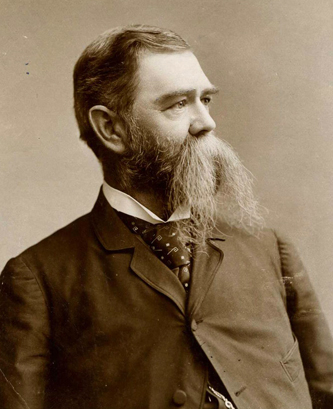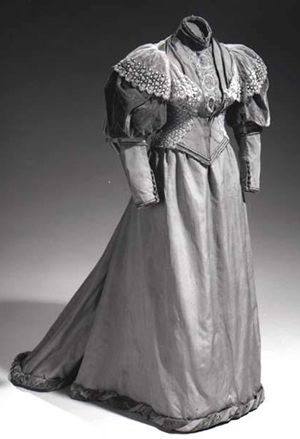25 Feb. 1839–22 July 1900
See also: Elias Carr, Research Branch, NC Office of Archives and History, Eleanor Carr

Elias Carr, planter, North Carolina State Farmers' Alliance Leader, and governor, was born at Bracebridge Hall, the family plantation in Edgecombe County near Old Sparta. Born into the planter aristocracy of Eastern North Carolina, he was the son of Jonas Johnston and Elizabeth Jane Hilliard Carr. Jonas J. Carr was the son of Elias and Celia Johnston Carr, whose father was Colonel Jonas Johnston of Revolutionary War fame. Elizabeth Hilliard Carr was the daughter of James and Mourning Boddie Hilliard, who resided in Nash County. Both the Carrs and the Hilliards were among the earliest settlers of North Carolina and held their deeds of lands directly from the Lords Proprietors of the colonial period. Jonas J. Carr built Bracebridge Hall on the Tar River near his father's house, Aspen Hall. Constructed over a two-year period and completed in August 1832, the fine residence was surrounded by over two thousand acres of lush farmland.
Elias Carr was the third child born to his parents. An older sister, Mary, later married David Hinton and became the mistress of Midway Plantation near Raleigh; an older brother, William, ultimately settled in Warren County and died in 1871. A fourth child, James Hilliard, died in infancy. Elizabeth Hilliard Carr died in childbirth on 25 Dec. 1840, and Jonas J. Carr died on 16 May 1843. Left an orphan at an early age, Carr was reared by his aunt and uncle, Temperance Boddie and John Buxton Williams of Warren County.
Carr attended school in Warren County and also the famous William James Bingham School at the Oaks in Orange County. His higher education was acquired at The University of North Carolina (1855–57) and later at the University of Virginia.
On 24 May 1859, Carr married Eleanor Kearny, born on 1 Mar. 1840 at Shocco Springs in Warren County, the daughter of William Kinchin and Maria Alston Kearny. She was well educated and of distinguished lineage. Elias and Eleanor Kearny Carr had six children: William Kearny (b. 1860); John Buxton (b. 1862); Mary, who died in infancy; Elias, Jr. (b. 1866); Eleanor Kearny; and Annie Bruce.
Carr purchased his brother William's share of the family plantation and with his bride settled at Bracebridge Hall. Hardly had he commenced his farming activities when the Civil War began. On 3 Sept. 1861 he enlisted as a private in Company G, Forty-first Regiment, Third Cavalry. A few months after his enlistment he was ordered to return home and operate his farm for the use of the Confederacy, but toward the war's end he saw active military service.
By the use of scientific methods, Carr gained widespread fame as a highly successful agriculturist who prospered even during periods of depression for most farmers. He realized early the merits of diversification and, in addition to growing cotton and later some tobacco, he produced corn, peas, fruits, and vegetables for home consumption and peanuts for market. A dairyman with a herd of purebred cattle, he sold milk and butter. He produced ensilage and educated farmers in the building of silos. He also marketed bricks and lumber. His meticulous habits led him to keep detailed records on such subjects as amount of rainfall, milk and butter production, and expenditures and returns; he knew the cost of cultivation and returns of each field and the milk production of each cow. A man of wealth, he owned several farms in Eastern North Carolina. Supplementing farming with some business activity, he was a stockholder in the Rocky Mount Mills and other enterprises. He lived the life of a country gentleman, and Bracebridge Hall epitomized southern hospitality.
Civic- and fraternal-minded, Carr was elected in 1869 to the school committee for Sparta Township. He also served for about fifteen years on the Edgecombe County Board of Commissioners. Proud of his ancestry, he was a charter member and first president of the North Carolina Society of the Sons of the Revolution, organized in 1893. Most of his public service revolved around agriculture. He was first president of the Farmer's Institute of Edgecombe County, established for the purpose of instructing farmers in better methods. He was commissioned by the governor as a state delegate in 1886 to the National Farmer's Congress in St. Paul, Minn., and in 1893 to the World's Columbian Exposition in Chicago. From 1891 to 1893 he served as a member of the board of managers of the North Carolina Geological Survey.
Carr's first major service was as the first president of the North Carolina Farmer's Association, established in Raleigh in 1887. The primary purpose of the organization was to secure the establishment of an agricultural and mechanical college, an objective achieved in 1888. Carr became a member of the first board of trustees of the North Carolina Agricultural and Mechanic College.

The Farmers' Alliance movement catapulted Carr into the limelight. The Southern Alliance was established in North Carolina in 1887 and in January 1888 absorbed the Farmer's Association. An early leader in the movement, Carr was president of his sub-alliance, Sparta, No. 218, and of the Edgecombe County Alliance. He served on the first executive committee of the NCSFA until August 1889, when he was elected president of the organization. Reelected in 1890, he served the maximum term of two years. His leadership helped to secure the passage of an act to increase the school tax for improved schools. As an Allianceman he was instrumental in drafting the Ocala platform, adopted at the Ocala, Fla., convention in 1890. However, he opposed the 1892 St. Louis platform, which ignored the protective tariff (an issue important to Carr) and substituted government ownership and operation of railroads for government regulation and control. A staunch Democrat, he opposed the third-party movement that developed among Alliancemen and ultimately resulted in the formation of the Populist party.
In 1892 the Democratic party nominated Carr for governor. Politically unambitious, he accepted nonetheless, agreeing that he seemed the likely candidate to unify farmers behind the Democratic ticket. He received 135,519 votes; Republican candidate David M. Furches received 94,684; and Populist candidate Wyatt Exum, 47,840.
Lack of political experience did not lessen Carr's firmness and decisiveness in the gubernatorial office. His management of public affairs was as meticulous, efficient, and responsible as his handling of private affairs. His appointments generally were men of high caliber, and he periodically visited and inspected the state's educational, eleemosynary, and penal institutions. During the last years of his administration the penitentiary was self-supporting for the first time in its history. Some of his policies smacked of Bourbon democracy. He sought to publicize the resources of his state so as to attract both immigrants and capital. Accordingly, he published two articles: "North Carolina's Resources," in Southern States 1 (1893), and "Some Advantages Offered by the Southern States," in Harper's Weekly, 11 Nov. 1893. He encouraged the state's participation in such fairs as the Atlanta Exposition (1895) and the Baltimore Centennial Exposition (1897). He also supported the state geological survey, an Alliance achievement, and he regarded the money appropriated as the best investment made by the state for any single purpose.
The policies he advocated were enlightened, progressive, and humane. He attempted to improve the state's schools and roads. In his inaugural address he termed the roads "a disgrace to civilization." His main concern was the establishment of better rural schools, and he advocated both increased taxation and compulsory education. His desire to expand public services was somewhat restrained by his reluctance to impose a heavier tax burden on the people, especially farmers, during a period of depression. The most controversial action of his administration was the lease in August 1895 of the North Carolina Railroad to the Southern Railway for ninety-nine years. He was often at odds with the Fusionist legislature of 1895, and when his term ended, the Fusionists had won control of all three branches of state government. But his message to the General Assembly of 1897, just prior to leaving office, was dignified and free of partisan rancor.
Carr retired to the farm life he loved at Bracebridge Hall, where he died. He was buried in the family cemetery there.